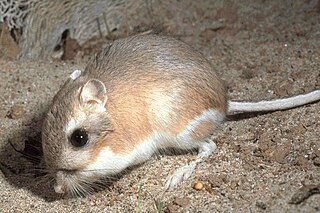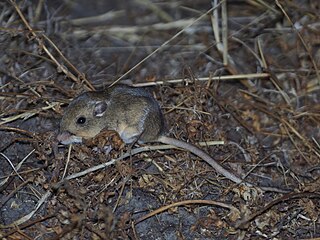
Kangaroo rats, small mostly nocturnal rodents of genus Dipodomys, are native to arid areas of western North America. The common name derives from their bipedal form. They hop in a manner similar to the much larger kangaroo, but developed this mode of locomotion independently, like several other clades of rodents.

Heteromyidae is a family of rodents consisting of kangaroo rats, kangaroo mice, pocket mice and spiny pocket mice. Most heteromyids live in complex burrows within the deserts and grasslands of western North America, though species within the genus Heteromys are also found in forests and their range extends as far south as northern South America. They feed mostly on seeds and other plant parts, which they carry in their fur-lined cheek pouches to their burrows.

A kangaroo mouse is either one of the two species of jumping mouse native to the deserts of the southwestern United States, predominantly found in the state of Nevada. The name "kangaroo mouse" refers to the species' extraordinary jumping ability, as well as its habit of bipedal locomotion. The two species are:

Perognathus is a genus of pocket mouse. Like other members of their family they are more closely related to pocket gophers than to true mice.

Perognathinae is a subfamily of rodents consisting of two genera of pocket mice. Most species live in complex burrows within the deserts and grasslands of western North America, They feed mostly on seeds and other plant parts, which they carry in their fur-lined cheek pouches to their burrows.
The Arizona pocket mouse is a rodent native to the Sonoran desert. It is a small mouse with a thinly furred tail that is smooth from base to tip. In color it ranges from tan to orange. It is a nocturnal, burrowing animal. It eats seeds, which it carries back to its burrow in its cheek pouches.

Bailey's pocket mouse is a species of rodent of the subfamily Perognathinae, family Heteromyidae. It is found in Baja California, Sinaloa and Sonora in Mexico and in California, Arizona and New Mexico in the United States.

The California pocket mouse is a species of nocturnal and primarily solitary rodent in the family Heteromyidae.

The San Diego pocket mouse is a rodent species in the family Heteromyidae. It occupies the northern region of Baja California near San Diego extending into Mexico.

Merriam's kangaroo rat is a species of rodent in the family Heteromyidae. The species name commemorates Clinton Hart Merriam. It is found in the Upper and Lower Sonoran life zones of the southwestern United States, Baja California, and northern Mexico.

Phillips's kangaroo rat is a species of rodent in the family Heteromyidae. It is endemic to Mexico. Its natural habitat is hot deserts.

The banner-tailed kangaroo rat is a species of rodent in the family Heteromyidae. It is found in arid environments in the southwestern United States and Mexico where it lives in a burrow by day and forages for seeds and plant matter by night.
The dark kangaroo mouse is a species of rodent in the family Heteromyidae. It is found in California, Idaho, Nevada, Oregon and Utah in the United States.

The olive-backed pocket mouse is a species of rodent in the family Heteromyidae. It is found in the central Great Plains of Canada and the United States where it is widespread and relatively common; the IUCN considers it to be of "least concern".

The silky pocket mouse is a species of rodent in the family Heteromyidae. It is found in northern and central Mexico and the southwest region of the United States. It is a species of least concern, according to the IUCN, with no known major threats. The silky pocket mouse eats seeds, succulent parts of plants and nuts, and carries food in its cheek pouches. It lives in low valley bottoms with soft soils, among weeds and shrubs, where it burrows in the sand to bury seed caches. The species is more tolerant of harsh habitat conditions than other pocket mice.

The little pocket mouse is a species of rodent in the family Heteromyidae. It is found in Baja California and Sonora in Mexico and in Arizona, California, Idaho, Nevada, Oregon and Utah in the United States. Its natural habitat is subtropical or tropical dry lowland grassland. It is a common species and faces no particular threats and the IUCN has listed it as being of "least concern".

Merriam's pocket mouse is a species of rodent in the family Heteromyidae. It is found in northeast Mexico and New Mexico, Oklahoma and Texas in the United States. Its habitat is shortgrass prairie, desert areas with scrub and arid shrubland. The species is named to honor Clinton Hart Merriam, a biologist who first described several other members of the genus Perognathus, and first elucidated the principle of a "life zone" as a means of characterizing ecological areas with similar plant and animal communities.

The Great Basin pocket mouse is a species of rodent in the family Heteromyidae. It is found in British Columbia in Canada and the western United States.

The Pacific pocket mouse, Perognathus longimembris pacificus, is endemic to California. It lives in sandy coastal soils of the coastal sage scrub ecoregion. It eats seeds and some insects. It was believed to be extinct until 1993, when a small population was discovered. It is now a federally listed Endangered animal species.

















